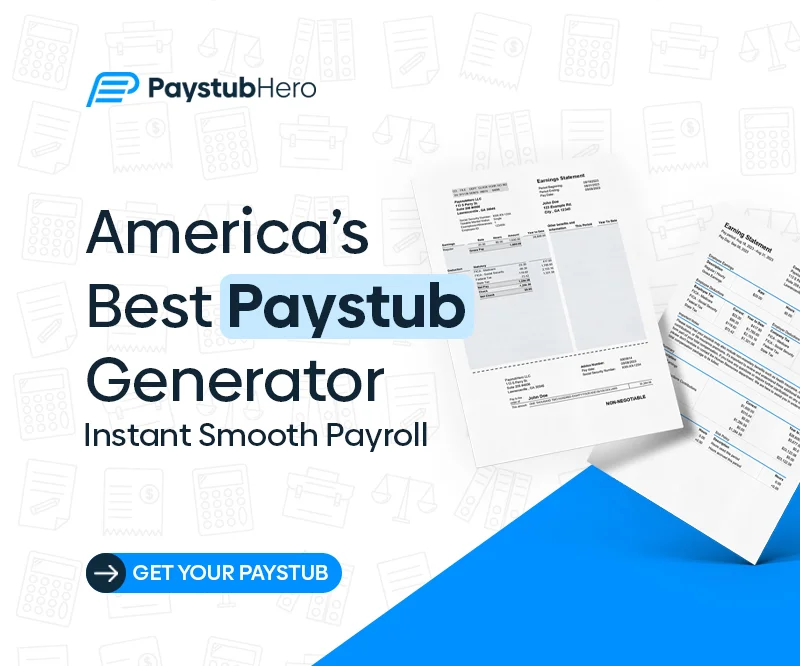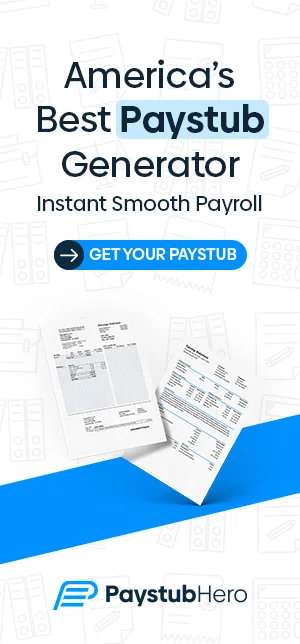When you are self-employed, you often need to show proof of your income for various money matters. Paystubs, bank statements, and W-2 forms are the usual go-to’s for proving how much you earn.
In this article, we’ll dig into these methods and show how they can help you.
Understanding Proof of Income
Proof of income is a verification system used to confirm your financial standing. It’s essentially documentation that shows you have a steady income stream and can meet your financial obligations.
How Does Proof of Income Help?
Provide proof of income benefits to both you and the party requesting it.
Here’s how:
• For You:
It strengthens your application for loans, credit cards, or even certain services like renting an apartment. By demonstrating your ability to repay, you increase your chances of approval and potentially secure better terms.
• For the Other Party:
Landlords, lenders, or service providers use proof of income to assess your financial stability. This helps them decide if they should approve your application and if you can afford the monthly payments.
When is Proof of Income Needed?
There are several situations where you might be asked to provide proof of income:
• Renting an Apartment: Landlords typically require proof of income to assess if your income can comfortably cover the rent and associated costs.
• Applying for a Loan: When seeking a mortgage, auto loan, or any other type, lenders will require proof of income. This is to determine your eligibility and how much you can borrow.
• Obtaining Credit Cards: Credit card companies use proof of income to evaluate your ability to repay potential debt and set your credit limit accordingly.
• Starting Utilities: Some utility companies might request proof of income to establish service, especially if you have no credit history.
How To Prove Income When Self Employed
Below are seven points explaining how to prove income when you’re self employed.
1. Self-Employed Pay Stubs
As a self-employed individual, you may not receive traditional pay stubs like those from an employer. Instead, you can create your own pay stubs to keep track of your income. These pay stubs usually contain your name, business name, and other details, as discussed below.
They serve as a record of your earnings and can demonstrate your financial stability when necessary.
What’s Included?
A self-employed pay stub should mirror a traditional one as much as possible. Key elements include:
• Your Business Information: Name, address, and Employer Identification Number (EIN) if you have one.
• Pay Period: The specific timeframe (weekly, bi-weekly, monthly) the income represents.
• Deductions: Estimated federal and state taxes (remember, you’re responsible for setting these aside). This might also include business expenses you’ve paid yourself.
• Gross Pay: The total income you earned before deductions.
• Net Pay: Your take-home pay after subtracting deductions from gross income.
Interesting Read: Gross vs Net Income – Understanding your Paystub
Here is a typical example of how your paystub should look like.
2. 1099 Forms
1099 forms are informational tax documents issued by the companies you did freelance or contract work for in the US. They report the total income they paid you during the tax year, typically if it’s over $600.
They come in different forms.
Different Types of 1099 Forms
There are several types of 1099 forms, each reporting a specific type of income:
• Form 1099-NEC (Nonemployee Compensation): This is the most common form for independent contractors and freelancers. It reports payments for services offered.
• Form 1099-K (Payment Card and Third Party Network Transactions): This form reports income received from payment settlement companies like PayPal or Venmo. It is basically for sales of goods or services.
• Form 1099-MISC (Miscellaneous Income): This form covers different income sources, such as rent payments, royalties, prizes, and specific medical payments.
From the above, 1099 forms indicate your income from various clients, showing multiple income sources.
3. Bank Statements
While 1099s are essential for verifying income, your business bank statements give more detailed information. They show every deposit made to your account, including money from clients, as happens throughout the year.
Here is an illustration:
This detailed record is highly valuable for showcasing consistent cash flow. Business lenders or potential investors often seek this consistency.
However, it’ important to note that they can be confusing due to a mix of personal and business transactions.
Here’s how to make bank statements work for income verification:
• Highlighting Relevant Deposits: Don’t expect recipients to sift through every entry. Use annotations, colored highlighting, or summaries to pinpoint income deposits.
• Categorizing Deposits: If possible, categorize deposits by client or project. This will show varied income and simplify verification.
• Focus on the Relevant Period: If verification is for a specific time, adjust the statements to cover only that period. This reduces clutter and keeps the focus on the relevant income data.
4. Tax Returns
Your tax return, particularly Form 1040 in the US, also helps verify income if you’re self-employed. This official government form outlines your total revenue for the entire tax year and lists all your business expenses.
It gives a detailed view of your financial performance and how much you could earn.
Now, although tax returns are reliable, they might not show income below a specific amount. This means if you made less than that amount, it might not show up on your tax papers.
5. Profit and Loss Statements (P&Ls)
A Profit and Loss (P&L) statement, or income statement, displays your business’s financial performance over time. This period can be like a month, quarter, or year.
It’s basically a scorecard for your business health.
Here’s what a P&L statement breaks down:
• Income (Revenue): This is the total money you make from selling products or services.
• Expenses: This is all the money you spend to run your business, including rent, salaries, supplies, and taxes.
The key takeaway from a P&L is your net profit, which is simply your income minus your expenses. It shows you if your business is making money (positive net profit) or losing money (negative net profit).
An example is shown below.
P&Ls are especially important for businesses with a track record. When applying for loans or investments, a strong P&L shows more than just making money.
It shows you can manage expenses and turn a profit, making you a reliable borrower or investment opportunity.
6. Client Letters
Client letters, though less formal than tax documents, can enhance the credibility and context of your income verification. This is especially valuable for freelancers or individuals with short-term contracts.
To give you an idea, a good client letter should ideally have:
• Client contact information
• A clear statement confirming the services you provided
• The project duration
• The agreed-upon compensation amount
• A positive endorsement of your work (optional but highly impactful)
A client letter works like a strong recommendation. It shows someone hired you, what you did for them, and how much they paid. This is useful when your income isn’t documented yet, like on tax returns, or if you have many short-term clients.
7. Invoices and Contracts
Invoices are records of your services and how much your client agreed to pay. They should include:
• Your name or business name
• Contact information
• A unique invoice number
• The date of issue
• A clear description of the services provided
• The associated costs
• The total amount due
• Payment terms
• Preferred payment methods
Contracts, on the other hand, explain how you and your clients will work together. They usually say what work will be done, how much you’ll be paid, and when. Using contracts along with invoices gives extra proof of your income.
It also shows your clients are trustworthy.
Get Proof of Income Documents With Paystub Hero!
Now you’ve got the know-how on income verification, but where do you get the documents? Paystub Hero simplifies it for you!
We provide everything you need: self employed paystubs, 1099 forms, offer letters, and all professional documents that serve as proof of income.
The process is simple:
• Enter your basic details.
• Preview the information for accuracy.
• Download or email your self-employed pay stub or the document of your choice.
This user-friendly approach saves you valuable time and eliminates the complexities of manual income verification. This means you can focus on what matters most—growing your business.
Get started today and prove your income with ease!
Frequent Asked Questions
Here are some common questions about proving income when you’re self-employed:
u003cstrongu003eHow do I show more proof of income?u003c/strongu003e
You can combine documents to show more proof of income as a self-employed individual. These include your annual tax return (Form 1040), 1099 forms, bank statements, profit/loss statements, and self-employed pay stubs.
u003cstrongu003eWhat is an income statement for self-employed?u003c/strongu003e
An income statement for self-employed people shows how much money their business made and spent during a certain time. It covers income, costs, expenses, and the final profit or loss.
u003cstrongu003eHow do you account for self-employment income?u003c/strongu003e
Self-employment income is usually managed by keeping records of all business earnings and spending throughout the year. This involves tracking income from clients or customers and noting expenses like equipment, software, and office expenses.
u003cstrongu003eWhat is evidence of income?u003c/strongu003e
Evidence of income refers to documentation that proves an individual’s income over a specific period. For self-employed individuals, this can include tax returns, 1099 forms, bank statements, profit/loss statements, and self-employed pay stubs.
u003cstrongu003eHow do you prove income when paid in cash?u003c/strongu003e
To prove cash-based income, maintain accurate records of all payments, and provide receipts or invoices for transactions. Reporting cash income on tax returns is also important.





